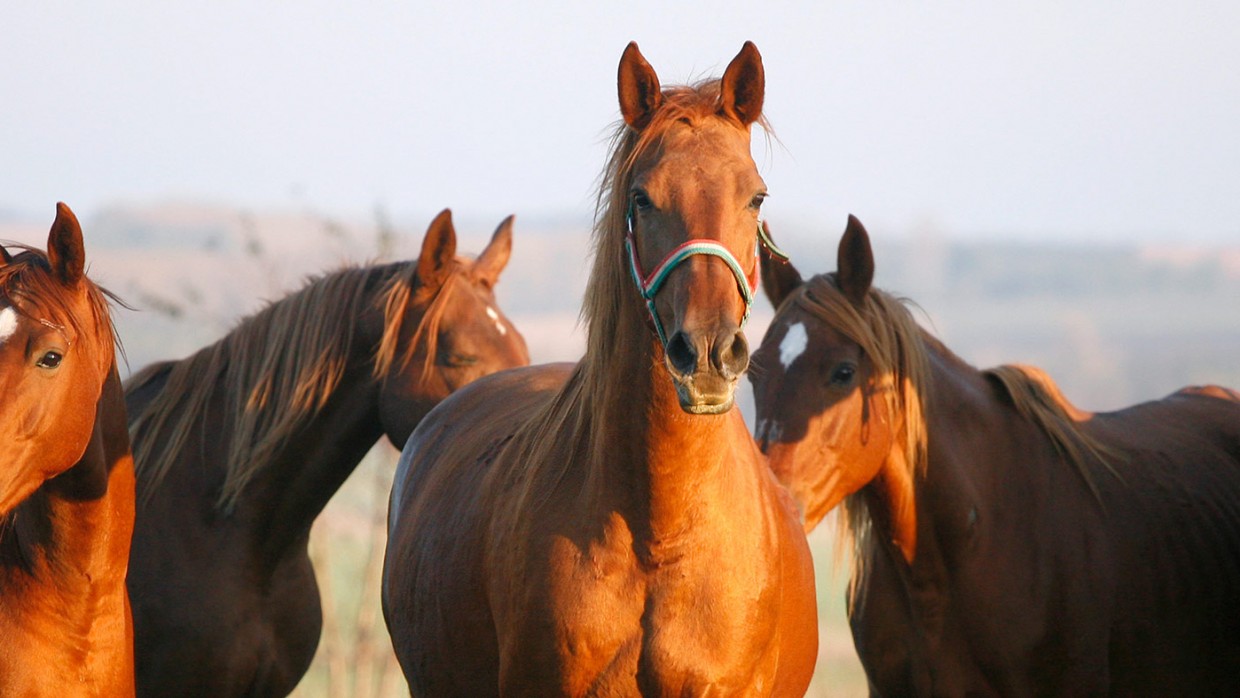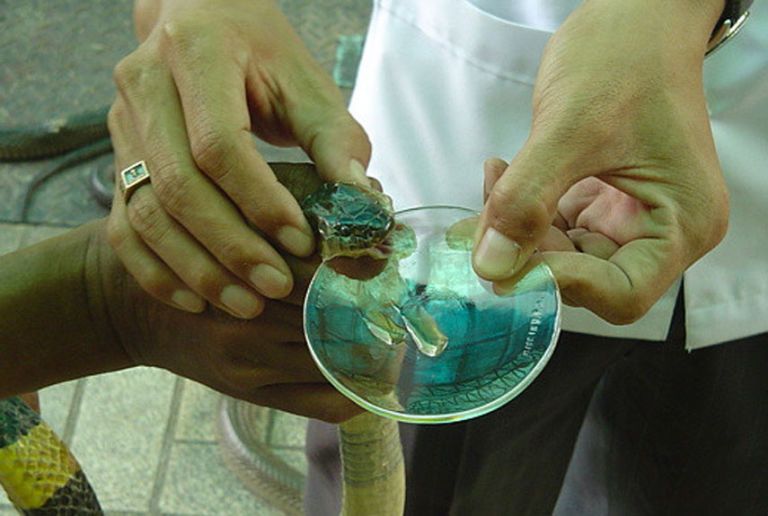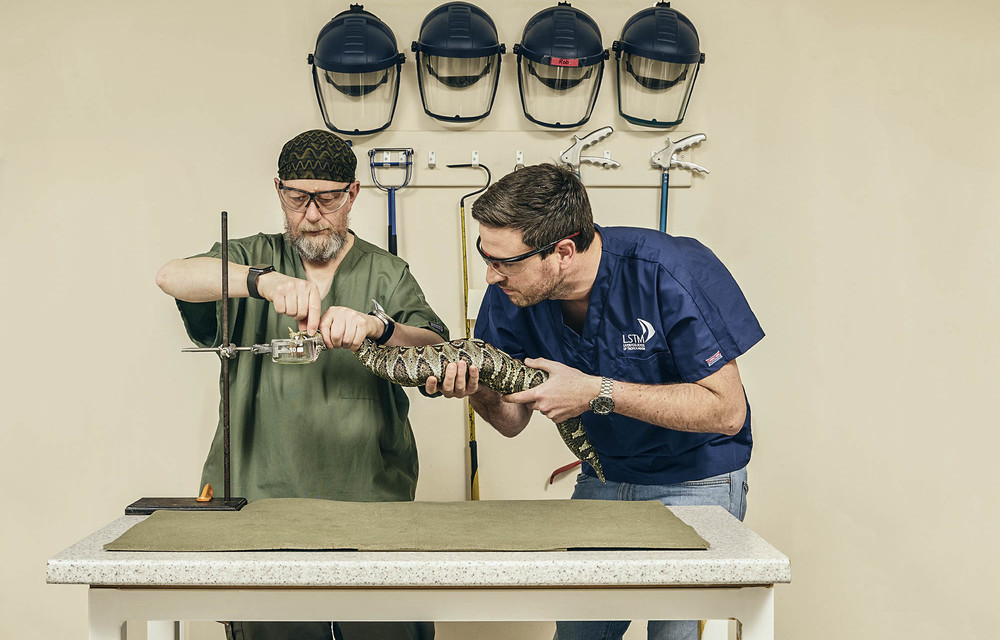Antivenoms are purified antibodies against venoms or venom components. Antivenoms are produced from antibodies made by animals to injected venoms. Antivenom is the only definitive treatment for effective bites by venomous Australian snakes. Prior to the availability of antivenom, death ensued in approximately 45% of tiger snake envenomations and more than 90% of taipan envenomations. The decision to use antivenom should be based on the patient's history, examination and pathologic findings, and the type of antivenom used will depend on geographic, clinical and pathologic factors.

The most commonly used animal in the production of Australian antivenoms is the horse. Sheep, rabbits and dogs are also currently used in Australia.
HOW IS ANTIVENOM MADE?
Venom is obtained from the various creatures in different ways. Snakes and funnel web spiders are milked for their venom. Stonefish, redback spider and box jellyfish antivenoms are made from venom extracted from the animal by dissection. This may be a dangerous process.
Small doses of venom or venom components are injected into the animal, and the dose gradually increased as the animal builds up a tolerance to the venom. In response to the introduction of the venom (a foreign substance), the animal produces antibodies to the venom. When the doses being injected are large, the amount of antibody produced is large.
These antibodies are harvested by taking blood from the animals and separating out the antibodies, which are then fragmented and purified by a series of digestion and processing steps.

Horse blood inoculated with tiger and brown snake venoms
When injected into a patient, the binding sites on the antibody fragments bind to the venoms or venom components in the circulation and neutralize the activity of the venoms in the patient. Antivenoms have been made since the 1890s.
Australia was one of the first countries in the world to experiment with snake antivenoms, in 1898, when Frank Tidswell commenced immunization of a former ambulance horse with tiger snake (N. scutatus) venom.
CSL Ltd is the sole manufacturer of antivenoms for human use in Australia. Australian antivenoms are amongst the best in the world, in terms of purity and adverse reaction rate.
|
Australian Snake Antivenoms |
Produced in: |
Other Australian Antivenoms |
Produced in: |
|
Tiger snake antivenom |
Horses |
Funnel web spider antivenom |
Rabbits |
|
Brown snake antivenom |
Horses |
Redback spider antivenom |
Horses |
|
Taipan antivenom |
Horses |
Australian paralysis tick antivenom |
Dogs |
|
Black snake antivenom |
Horses |
Box jellyfish antivenom |
Sheep |
|
Death adder antivenom |
Horses |
Stonefish antivenom |
Horses |
|
Sea snake antivenom |
Horses |
||
|
Polyvalent snake antivenom |
Horses |
CHOICE OF ANTIVENOM: SNAKE IDENTIFICATION
Identification of the offending snake will aid in the choice of the appropriate antivenom and alert clinicians to particular features characteristic of envenomation by that type of snake.
In cases of snakebite involving zoo staff, herpetologists or other experienced snake handlers, the snake’s identity may be known (although this cannot always be relied upon, particularly in the case of enthusiastic amateurs).
Identification of snakes by the general public or by hospital staff is frequently unreliable. Sometimes, the snake is not seen, or is only glimpsed in retreat. In these cases, a snakebite venom detection kit may be used.

CSL Snake Venom Detection Kit including contents and packaging.
Australia is the only country in the world that has snake venom detection kits.They consist of a rapid two step enzyme immunoassay in which wells are coated with antibodies to the various snake venoms. A swab from the bite site, blood, or urine helps to select the type of snake antivenom which may have to be used. Note that the primary purpose of the venom detection kit is not to decide whether envenomation has occurred (i.e. whether antivenom is indicated), but to help to choose the appropriate antivenom if required
How to Make Antivenom
Antivenom Technology
However, 100,000 people worldwide each year are not so lucky. Despite the fact that humans learned how to make antivenom more than 100 years ago, there are critical shortages of virtually every kind of it, especially in developing countries. But why?
Making antivenom is a painstaking, resource-intensive, time-consuming process. It's not much different now than when it was first created in the 1890s by a protege of Louis Pasteur named Albert Calmette, who was living in present-day Vietnam when a flood forced monocled cobras into a village near Saigon, where they bit at least 40 people and killed four. Inspired by the then-new science of vaccinations, by 1896 Calmette had discovered the process of injecting horses with venom until they produced antibodies, taking the serum out of their blood and injecting it into snake-bitten humans as antivenom.
Leslie Boyer, a physician and head of the VIPER Institute at the University of Arizona, says the process is much improved a century later, but the steps remain largely the same. She and other antivenom experts walk us through how they create the antidote to the world's deadliest snakebites.

Step 1: Milking The Venom
Next, grab the snake with the thumb and index finger at the very back of the head, just behind the angle of the jaw where the venom glands reside. This allows you to press on the glands while preventing the snake from turning its head and striking you. Opening a snake's jaws may require gentle pressure, and with vipers, you might have to use forceps to swivel their fangs into the upright position and pull back the sheath covering the fang's hollow tip.
Take a vial and cover it with a rubber or plastic film. Then, snake in hand, push the fangs through the plastic (or let the snake simply strike on its own). Gently squeeze the glands to get out all the venom. In some cases, antivenom makers use a weak electric current to stimulate venom excretion. Carefully remove the fangs from the film. Snakes with fangs in the back of their mouths, such as colubrids, may require special tubes to bite into, which drain into a collection vial.
To get enough venom, each snake must be milked many times. For example, in 1965, the National Institutes of Health asked Haast, who founded the Miami Serpentarium, to produce 1 pint of coral snake venom. It took him, a man of unrivaled skill and patience, a total of three years and 69,000 milkings to get that much, from which the first and only American coral antivenom was made. Wyeth (now owned by Pfizer) produced this same antivenom until 2003, when it closed the factory. Since then the FDA–which must approve antivenom the same way it approves other drugs–has extended the expiration date of the scant remaining supplies three times because the supply threatens to run out soon.

Step 2: Cooling Down and Labeling

Step 3: Choosing an Animal for Immunization

Step 4: Immunizing
Inject a small amount (say a few milliliters) of the solution beneath the horse's skin, preferably on its rump or the back of its neck where lymph nodes and immune cells reside. It's usually a good idea to break up the shot into smaller doses in various locations to avoid causing an ulcer or sore on the skin and to maximize the surface area for an immune reaction. This part of the process can vary depending upon the type of antivenom, the company involved, the snake used and the sort of antibodies desired. The specific details are hush-hush. "These are closely guarded trade secrets by people who make antivenom worldwide–how much venom is administered in what fashion to get an immune response," Boyer says.
It's vital to have a trained veterinarian on hand to monitor the horse's health. If it tolerates the injection, you'll probably give it several more doses days or weeks apart. Antibodies in the horse's bloodstream peak after about eight to 10 weeks. At that point the horse is ready to be bled, which involves drawing 3 to 6 liters of blood from the jugular vein, according to WHO guidelines.

Step 5: Purifying
Now it's time to separate out the antivenom. Again, this multistep process varies by antivenom producer. Generally, it begins by getting rid of unwanted proteins. You do this by causing them to precipitate, or fall out, often by adjusting the plasma's pH or adding salts to the solution.
One of the last steps involves using an enzyme to break down the antibody into small parts and isolating its active ingredient. In the case of CroFab, the only FDA-licensed antivenom produced in the U.S. (which treats bites from all North American species except the coral snake), the sheep-derived antibodies are digested with the enzyme papain. Alvin Bronstein, medical director of the Rocky Mountain Poison Center, says this creates a small antibody with a much lower likelihood of causing an allergic reaction compared to its predecessor. "It's a revolutionary treatment for snakebite," he says.
Now that you've gone through all this effort, your antivenom still must be deemed safe and effective by the FDA, which can take another 10 years.

Step 6: Human Use
All these steps certainly add up on the balance sheet. Mike Touger, an emergency medicine specialist at Jacobi, says his group has paid as much as $1600 per vial of CroFab, and Boyer says a snakebite that needs antivenom requires an average of 20 to 25 vials. Touger recalls the case of a man bitten by a timber rattlesnake, whose venom disrupts blood's ability to form clots; the man bled for three weeks and went through 30 vials of CroFab. "That's $30,000 in pharmacy costs alone," Touger says. The patient survived, as has everyone treated for venomous snakebites at Jacobi since the treatment center opened in 1981. But the time and money required to make antivenom, combined with the fact that most deadly snakebites happen in developing countries, has decreased the financial incentive for drug companies to produce more antivenom, contributing to a worldwide shortage.
There's one other, quirkier way to make antivenom–one that physicians don't exactly recommend. For decades Bill Haast, who died this June at the age of 100, milked about 100 snakes a day with his bare hands, and in 1948 began injecting himself with increasing doses of diluted cobra venom in order to develop his own immune resistance. At the time of his death (not caused by snakebite), he'd survived 172 bites from many of the world's deadliest snakes, including a blue krait, a king cobra and a Pakistani pit viper. He flew around the world to donate transfusions of his antibody-rich blood to treat 21 snakebite victims. Venezuela made him an honorary citizen after he traveled into the jungle to donate blood to a young snake-bitten boy. According to his wife Nancy, all 21 patients survived.



